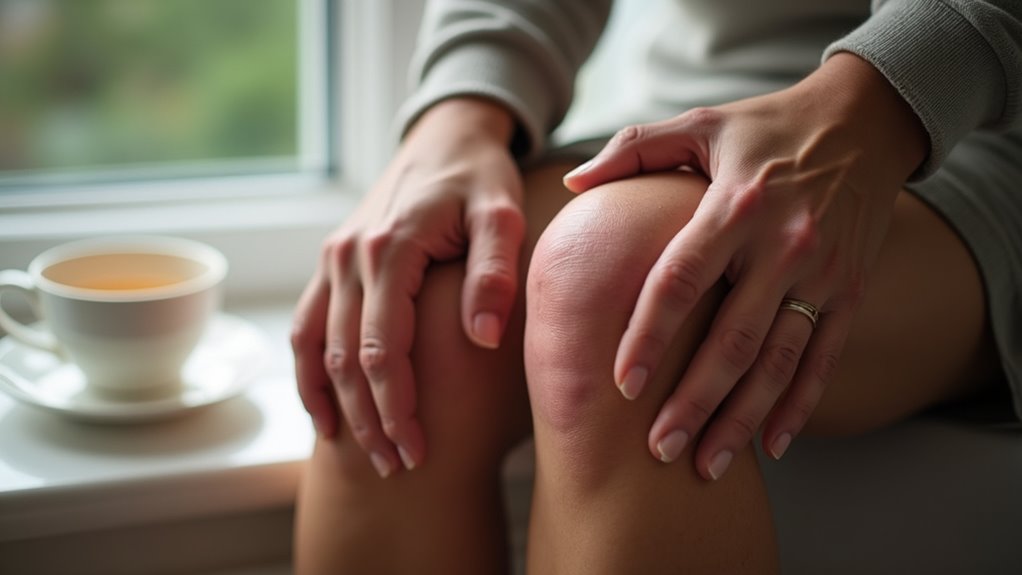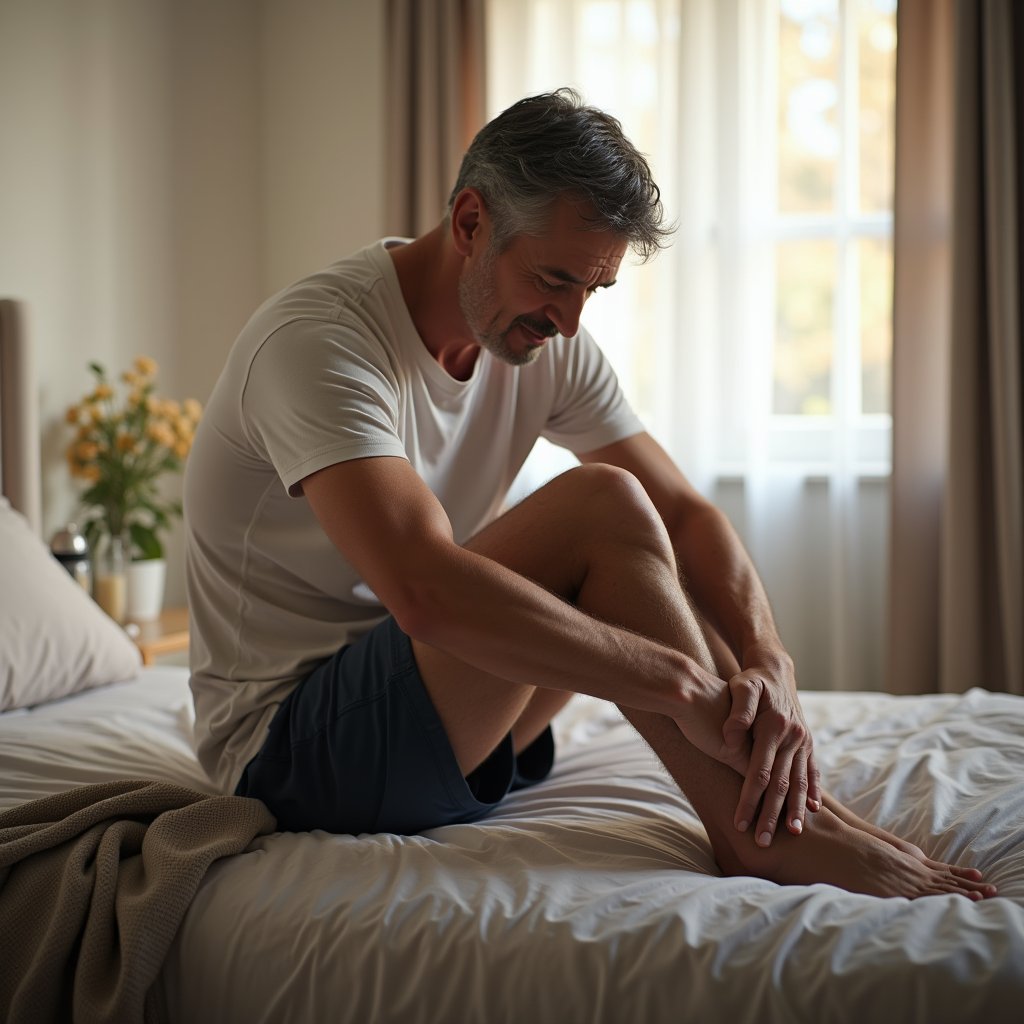Early warning signs of osteoarthritis include persistent joint pain that doesn’t improve with rest, morning stiffness lasting over 30 minutes, and swelling around joints. You’ll notice clicking or popping sounds during movement, especially in previously injured areas. Watch for reduced range of motion that makes daily tasks challenging, along with tenderness that persists for days. Understanding these early indicators can help you take essential preventive steps and manage symptoms effectively.
Persistent Joint Pain and Gradual Discomfort

When persistent joint pain gradually develops and doesn’t subside with rest, it may signal the onset of osteoarthritis. Unlike temporary discomfort from physical activity, osteoarthritis-related pain tends to worsen over time and becomes a constant presence in your daily life.
You’ll notice that your joint pain intensifies during or after activities, yet unlike normal exercise-related soreness, this discomfort persists even after you’ve rested. The pain’s progressive nature sets it apart from routine aches – it’s more steadfast and doesn’t improve with typical recovery methods. If you’re experiencing this kind of ongoing joint stiffness and pain, it’s essential to seek medical evaluation. Early detection of osteoarthritis symptoms allows for timely intervention and proper management of the condition.
Morning Stiffness and Limited Mobility

As cartilage deteriorates in your joints, morning stiffness and restricted mobility emerge as telltale signs of early osteoarthritis. If you’re experiencing joint stiffness that lasts more than 30 minutes after waking up, you’ll want to pay close attention to this warning signal.
You might notice that your joints feel particularly stiff during periods of inactivity, but the discomfort improves once you start moving. This pattern is characteristic of osteoarthritis development. A reduced range of motion in your joints can make everyday tasks challenging, especially when bending or extending affected areas. You’ll find that simple activities like climbing stairs or reaching for objects become increasingly difficult.
Don’t ignore these mobility changes – early intervention is essential for managing osteoarthritis progression and maintaining your joint function.
Swelling and Tenderness Around Joints

Swelling and tenderness around your joints serve as critical warning signs of osteoarthritis, indicating active inflammation in the affected areas. You’ll notice visible puffiness and increased sensitivity when touching the joint, which can profoundly influence your daily activities if left unmonitored. If you experience persistent swelling or tenderness that lasts several days or keeps returning, it is crucial to seek medical evaluation for proper diagnosis and early intervention.
Recognizing Joint Inflammation Signs
Because inflammation serves as a pivotal indicator of joint problems, recognizing the signs of joint swelling and tenderness can help you identify potential osteoarthritis in its early stages. When you notice swelling around your joints, particularly when accompanied by warmth or redness, it is crucial to monitor these symptoms carefully. These indicators often signal underlying joint inflammation that shouldn’t be ignored.
| Warning Sign | What to Look For | When to Act |
|---|---|---|
| Noticeable Swelling | Visible puffiness around joints | If persists > 2 days |
| Joint Warmth | Hot sensation when touched | If accompanied by redness |
| Tenderness | Pain when applying pressure | If affects daily activities |
| Visual Changes | Redness or skin changes | If spreading or worsening |
Don’t dismiss these symptoms as temporary discomfort. Early detection and proper medical evaluation can greatly impact your treatment outcomes and help manage developing arthritis effectively.
Managing Tender Joint Areas
The effective management of tender joint areas requires a systematic approach combining both immediate relief strategies and long-term therapeutic interventions.
When you notice joint swelling and stiffness, it’s essential to take immediate action. Apply ice packs to reduce inflammation and use over-the-counter pain relievers to manage discomfort. You’ll need to temporarily avoid activities that worsen your joint pain while implementing these relief measures.
For long-term management, consult your healthcare provider if swelling and tenderness persist or recur. They can evaluate your condition and recommend appropriate treatments. Physical therapy often plays a pivotal role, as targeted exercises strengthen the muscles surrounding affected joints. In cases where conservative treatments don’t provide sufficient relief, your doctor may suggest corticosteroid injections to address severe inflammation and tenderness.
Grating Sensations and Popping Sounds
When you hear clicking or popping sounds while moving your joints, you’re experiencing what medical professionals call crepitus, which can signal cartilage deterioration in your weight-bearing joints. You’ll often notice these sounds accompanied by a grating sensation, particularly when bending your knees or moving your hips. If you feel like your bones are rubbing together during movement, it’s paramount to seek medical evaluation, as this can indicate advancing osteoarthritis that requires professional attention.
Joint Sounds During Movement
Listening carefully to your joints during movement can reveal early warning signs of osteoarthritis, particularly through distinctive sounds like grinding, popping, or crackling sensations. These joint sounds, known medically as crepitus, often indicate underlying cartilage deterioration in pivotal areas like your knees and hips.
- Pay attention to grinding or grating noises when bending or straightening your joints
- Monitor for consistent popping sounds during regular movements
- Note any crackling sensations that occur with joint motion
- Track when these sounds are accompanied by pain or stiffness
Don’t ignore these warning signals from your body. If you’re experiencing persistent joint sounds during your daily activities, it is imperative to consult a healthcare provider. Early detection of osteoarthritis through these audible signs can lead to more effective treatment outcomes.
Feeling Bones Rub Together
Beyond the audible cues of joint sounds, you may experience distinct physical sensations that signal cartilage deterioration. When you feel a grinding or grating sensation in your joints during movement, particularly in your knees or hips, it’s often a warning sign that your protective cartilage has worn down.
This sensation, known medically as crepitus, occurs when bones begin rubbing directly against each other without adequate cushioning. You’ll likely notice this feeling accompanied by popping or crunching sensations during regular activities like walking up stairs or standing from a seated position. If you’re experiencing persistent grating sensations in your joints, don’t ignore these symptoms they’re crucial indicators of potential osteoarthritis. Schedule an appointment with your healthcare provider for a proper evaluation, as early detection can lead to better management of the condition.
Pain in Previously Injured Areas
Many individuals who develop osteoarthritis initially notice pain in joints that sustained previous injuries. When you’ve experienced trauma to a joint in the past, that area becomes substantially more vulnerable to developing arthritis later in life. The connection between previous injury and joint pain from osteoarthritis is well-documented in medical research.
- Your previously injured joints require extra monitoring for early signs of stiffness and discomfort
- Even minor past traumas can increase your risk of developing arthritis in those specific areas
- If you’ve had surgery or serious injury to a joint, watch closely for recurring pain years later
- Regular check-ups become particularly crucial for joints with a history of damage
Don’t dismiss persistent pain in previously injured areas – it could be an early indicator of developing osteoarthritis.
Changes in Joint Flexibility and Range
Your joints may feel unusually stiff when you wake up, making it difficult to perform simple tasks like getting out of bed or gripping a coffee mug. You’ll notice a progressive decline in your ability to fully bend or straighten affected joints, particularly after staying in one position for extended periods. These mobility restrictions often start subtly but become more pronounced over time, affecting your range of motion in everyday activities like climbing stairs or reaching overhead.
Morning Joint Stiffness
When joint stiffness persists for more than 30 minutes after waking up, it’s often one of the earliest indicators of osteoarthritis. This morning stiffness that lasts can profoundly impact your daily activities and signals progressive cartilage deterioration in your joints.
- You’ll notice reduced range of motion particularly after periods of inactivity, making simple tasks like reaching or bending increasingly challenging
- Your joints may feel as if they need “lubrication” to function properly, a classic sign of osteoarthritic changes
- The stiffness typically affects your range of motion most severely during morning hours, gradually improving with movement throughout the day
- If you’re experiencing persistent morning joint stiffness, it’s essential to recognize this as a warning sign that your joint cartilage may be wearing down
These symptoms warrant attention and professional medical evaluation to address potential osteoarthritis development.
Limited Bending Movements
Declining joint flexibility represents one of the most telling early indicators of osteoarthritis, particularly when bending movements become increasingly restricted. You’ll often notice difficulties with everyday tasks that require bending, such as tying shoelaces or picking up items from the floor. These limitations can affect multiple joints, especially your knees, hips, and fingers.
If you feel your range of motion diminishing over time, it’s vital to monitor these changes carefully. Joint pain and stiffness typically accompany reduced flexibility, making previously simple movements more challenging. Watch for progressive difficulty in activities that require joint mobility, as these changes may signal cartilage deterioration. Don’t hesitate to consult your healthcare provider if you notice persistent reductions in your joint flexibility, as early detection can lead to better management of osteoarthritis symptoms.
Gradual Mobility Loss
Joint mobility loss in osteoarthritis follows a predictable pattern, starting with subtle changes that many people initially dismiss. As the progression of the disease advances, you’ll notice increasing difficulty with daily activities that require flexible joints.
- Your joints will feel stiff and resistant when you first wake up or after periods of inactivity, taking longer to “warm up” than before
- You’ll find yourself modifying basic movements, like using handrails more frequently or avoiding deep seats
- Your range of motion will decrease gradually, making it harder to fully extend or bend affected joints
- You’ll experience reduced flexibility in specific movements, such as reaching overhead, squatting, or rotating joints
These mobility changes often develop over months or years, making it essential to recognize and address them early for better management of the condition.
Symptoms That Worsen With Activity
A telltale indicator of osteoarthritis emerges during or after physical activity, as affected joints respond with increased pain and stiffness. You’ll notice that persistent joint pain intensifies with movement and extended periods of use, particularly in weight-bearing joints. This discomfort typically subsides with rest but predictably returns once you resume activity.
If you’re experiencing pain or stiffness that consistently worsens after exercise or daily activities, don’t dismiss these symptoms. They’re significant indicators of cartilage deterioration within your joints. As osteoarthritis progresses, you’ll find that previously manageable activities become increasingly difficult due to heightened discomfort and reduced mobility. Understanding this pattern of activity-related symptom flares is essential for early detection and proper medical intervention. Pay attention to how your joints respond to physical exertion.
Weather-Related Joint Sensitivity
When weather patterns shift, particularly during damp or cold conditions, you might notice your joints becoming increasingly sensitive and painful. This weather-related joint sensitivity can serve as an early warning sign of osteoarthritis, especially when you experience discomfort in specific affected areas before or during weather changes.
- Your joints may act as natural barometers, becoming more painful when atmospheric pressure drops
- You’ll likely notice increased stiffness and aching in affected areas during rainy or humid conditions
- Cold weather can trigger more pronounced joint pain and reduced mobility
- You might experience these symptoms hours before visible weather changes occur
Understanding this connection between weather and joint sensitivity can help you better prepare for symptom flares. Consider tracking weather patterns alongside your symptoms to develop more effective management strategies.
Impact on Daily Activities and Movement
Everyday activities that you once performed effortlessly can become increasingly challenging as osteoarthritis develops in your joints. You may notice chronic pain and swelling in and around weight-bearing joints making it difficult to climb stairs, stand for extended periods, or enter and exit vehicles. These joint issues can greatly impact your independence and quality of life.
Simple tasks like opening jars, buttoning clothes, or holding small objects become frustrating as your grip strength and manual dexterity diminish. You’ll likely experience reduced range of motion and stiffness that interfere with basic self-care activities such as bathing, dressing, and grooming. If you’re finding these daily movements increasingly difficult, it is crucial to recognize them as potential warning signs of osteoarthritis and seek appropriate medical evaluation.
Physical Changes in Joint Appearance
Physical changes in your joints often serve as visible indicators of developing osteoarthritis. When examining affected joints, you’ll notice distinct transformations that signal early signs of this degenerative condition.
Joint changes provide clear warning signs of osteoarthritis, revealing visible transformations that alert you to this degenerative disease’s early stages.
- Your joints may appear swollen, red, and feel warm to the touch, indicating active inflammation and ongoing tissue damage within the joint structure
- You’ll notice visible deformities developing, particularly in finger joints, which can take on a knobby, enlarged appearance
- The areas around your affected joints may show decreased muscle mass, while the joint itself loses its normal range of flexibility
- During movement, you might observe or hear grinding and popping sounds, which suggest deterioration of cartilage beneath the surface
These physical changes shouldn’t be ignored, as they’re indispensable indicators of developing arthritis that require medical attention.
Frequently Asked Questions
What Is the Earliest Symptom of Osteoarthritis?
The earliest symptom you’ll notice is joint stiffness, particularly when you wake up in the morning or after periods of inactivity. You’ll experience this stiffness for about 30 minutes before it eases. As the condition progresses, you’ll begin to feel pain during activity and notice reduced mobility in affected joints. It’s imperative to recognize these initial signs, as early intervention can help manage the condition more effectively.
What Are the Red Flags of Osteoarthritis?
You should watch for several red flags with osteoarthritis. Pay attention to joint pain severity that doesn’t improve with rest or medication, especially if it’s disrupting your sleep. Be concerned if you’re experiencing mobility limitations that affect daily activities or if you can’t bear weight on affected joints. Also, monitor stiffness duration that lasts more than 30 minutes after waking. These symptoms warrant immediate medical evaluation to prevent further joint damage.
What Is the Life Expectancy of Someone With Osteoarthritis?
If you have osteoarthritis, you won’t typically experience a reduced life expectancy from the condition itself. However, you should be aware of potential disability progression and quality of life impacts that can affect your comprehensive health. With proper treatment options, including medication, physical therapy, and lifestyle modifications, you can effectively manage your symptoms. Your life expectancy mainly depends on other health factors, not the osteoarthritis diagnosis. Regular medical supervision is essential for ideal outcomes.
What Is Stage 4 Osteoarthritis?
Stage 4 osteoarthritis is the most advanced stage of the disease, where you’ll experience severe joint damage and significant pain. You’ll notice progressive joint deformity and extreme stiffness in affected areas. At this stage, you’re likely to face increased functional impairment, making daily activities extremely challenging. Your joints will show extensive cartilage loss, and you’ll typically see bone-on-bone contact in X-rays. It’s characterized by constant discomfort and substantially reduced mobility.






